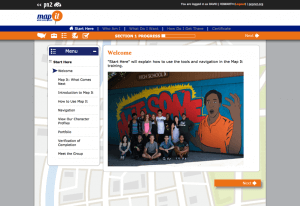Sparking learners’ motivation is one of the hardest things to do in online education. How do you engage individuals sitting alone at a computer? How do you get them to tackle new information and challenges?
One way to motivate learners is to immerse them in an online community. After all, it’s the social connections and interactions that make learning engaging. Community is the glue that holds your online class together. It allows learners to give opinions, share ideas, provide and receive feedback, and collaborate on issues and answer questions.
Creating this kind of participatory community doesn’t happen automatically. In this article, we’ll share the secrets of success in creating just such an online community of more than 16,000 users. Monarch Media’s client, pepnet2 (pn2), a national nonprofit that provides support to students who are deaf or hard of hearing, has developed a thriving site where users learn and support one another. Here are some of the best practices that Monarch incorporated in building pepnet 2’s online learning community:
Enable Diverse Interactions
With a learner base of more than 16,000, providing diverse resources was necessary to address all members’ needs. Monarch developed different kinds of interactive eLearning resources and support systems, including courses, webinar integration, QuickClasses, and communities of practice (COP).
Individuals seeking self-paced learning can turn to the asynchronous interactive courses, which include videos, assessments, and other activities that maximize learner involvement. This self-directed model allows students to set their own learning schedule that meet their individual needs. Although learners work independently on these courses, they can share their progress and achievements with the community by earning badges and certificates.
The QuickClasses support a more collective learning model through scheduled instructor and group collaboration. Rather than working individually, QuickClasses bring small groups of students together to build community, foster creativity, build leadership skills and encourage greater progress.
Finally, pn2 facilitates informal resource and expertise sharing through the communities of practice (COP). COPs consist of groups of people who share a common passion or interest and engage in collective learning within a shared domain. At their core is an ongoing discussion forum where they can post questions, weigh in on conversations, share resources, or learn from archived dialogue.
Make Usability Effortless
The success of eLearning depends heavily on how user-friendly it is. While pn2 was successful in creating various eLearning resources to cater to their diverse learner base, the designers had to work out a way to bring these resources together for the learners.
Usability is an essential ingredient for fostering user interaction. For pn2, a customized eLearning dashboard was critical. Through a single sign-in, learners have access to a fully customized dashboard that’s a one-stop access point for all resources offered. Learners can exchange ideas and knowledge by participating in QuickClasses, interacting with webinar content, connecting to colleagues through COPs, or learning new skills in an interactive eLearning course.
The dashboard is also a place to broadcast community news and to connect members with upcoming opportunities. Its effectiveness and efficiency helps connect learners to resources and to each other, engaging them in a satisfying experience.
Highlight Student Progress
Not only can members of a learning community work together to solve problems, they can also support and motivate each other by celebrating successes. An online community allows users to share their progress, collect badges, reflect on completed courses, and even share achievements through social media integration.
One way students can share their work is through ePortfolios, which are personal online spaces to save and display collections of digital work. These ePortfolios allow learners to share work they’ve completed and their accomplishments with peers, instructors, and potential employers.
Be Mobile Compatible
Another key to keeping learners engaged is making learning resources accessible on mobile devices. Smart phones and tablets are now the primary devices for Internet access, so making it easy for learners to engage that way only makes sense.
Follow Up with Your Users
A final word of advice is to learn from your users. Find ways to solicit direct feedback. Your site analytics will also give you insight into where people are spending their time and where they may be losing interest. Investigate the data and use it to inform your community development efforts.
Monarch Media’s team collaborated with pn2 to provide the learning design strategy, instructional design, graphic design, and programming needed to develop robust learning programs. With nearly 20 years of experience in eLearning consulting and development, we can help your organization build a successful online learning community that focuses on engaging and motivating your audience.
